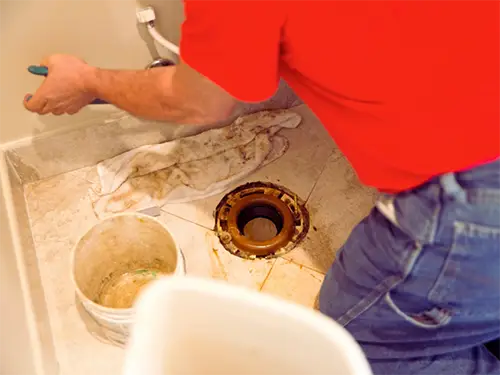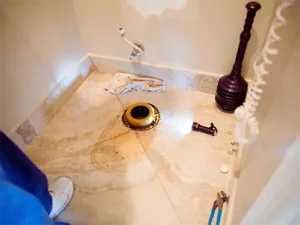 A leaking toilet is not just a small problem. It can cause high water bills and even damage to your home if you ignore it. One of the most overlooked components of a toilet installation is the wax ring. This unassuming but essential piece plays an important role in creating a watertight seal between your toilet and the plumbing system.
A leaking toilet is not just a small problem. It can cause high water bills and even damage to your home if you ignore it. One of the most overlooked components of a toilet installation is the wax ring. This unassuming but essential piece plays an important role in creating a watertight seal between your toilet and the plumbing system.
Selecting the correct toilet wax ring size and type is essential for preventing leaks, odors, and long-term damage.
In this guide, we’ll dive into the different types of wax rings, how to choose the right one, and the factors you need to consider before making a decision.
Key Takeaways
- Wax rings create a watertight seal between the toilet base and the flange.
- Not all wax rings are the same; they vary in size and type to suit different setups.
- Factors such as flange height, flooring type, and installation experience impact your choice of wax ring.
- Wax-free options offer advantages for certain conditions, like heated floors and DIY installations.
- Professional assistance may be necessary for older systems or challenging setups.
What Is a Wax Ring & What Does It Do?
A toilet wax ring is a soft, pliable seal that sits between the toilet’s base and the flange connected to your plumbing system. Its primary purpose is to prevent water and sewer gas from escaping into your bathroom. This wax seal is crucial for maintaining a clean, odor-free, and watertight environment around your toilet.
The pliability of the wax allows it to fill in gaps between uneven surfaces, ensuring a snug and reliable fit. This is especially important in older homes where floors and plumbing connections may not be perfectly aligned.
However, choosing the wrong size or type of wax ring can compromise the seal, leading to leaks, odors, or even damage to your bathroom floor. When properly installed, a wax ring is nearly invisible yet essential for a functional and hygienic toilet system.
Types of Toilet Wax Rings and When to Use Them
Not all wax rings are created equal. Depending on your toilet flange’s position and the overall setup of your bathroom, you’ll need a specific type of wax ring. Here’s a breakdown of the most common types:
Standard Wax Ring
- Best For: Flanges positioned on top the finished floor.
- Details: This is the simplest and most commonly used wax ring. It’s cost-effective and works well for standard toilet installations.
Jumbo Wax Ring
- Best For: Flanges that are level with the floor.
- Details: A thicker wax ring designed to provide a more robust seal for situations where the flange and floor are flush.
Reinforced Wax Ring
- Best For: Heavy-duty applications.
- Details: Features a plastic funnel or bell that adds durability and alignment support.
Jumbo Reinforced Wax Ring
- Best For: Recessed or uneven flange installations.
- Details: Combines the thickness of a jumbo ring with the reinforcement of a plastic funnel for challenging scenarios.
Key Consideration: Flange Position
Always inspect the height and alignment of your flange before choosing a wax ring. The wrong choice can lead to costly repairs down the road.
 Factors to Consider Before Choosing a Toilet Wax Ring
Factors to Consider Before Choosing a Toilet Wax Ring
Selecting the right wax ring isn’t just about picking one off the shelf of your local hardware store. Consider these factors to ensure a successful installation:
Flooring Type
Heated floors pose a unique challenge for wax rings, as the heat can cause the wax to soften or melt over time. Wax-free seals are a better option in these situations.
DIY Experience
Wax rings can be messy and require precise alignment. If you’re new to toilet repairs, wax-free seals may be easier to work with and reduce the margin for error.
Reusability
Traditional wax rings must be replaced whenever the toilet is removed, while wax-free seals can be reused if they’re still in good condition.
Installation Challenges
If your toilet is slightly misaligned during installation, a wax ring can lose its seal. Wax-free seals offer more flexibility and are less prone to leaking in such cases.
Wax Ring vs. Wax-Free Seal
When deciding between a wax ring and a wax-free seal, it’s essential to weigh the pros and cons of each option.
Wax Ring Pros
- Widely available and affordable.
- Proven reliability for creating a watertight seal.
- Ideal for most standard installations.
Wax-Free Seal Benefits
- Reusable and less messy.
- Better suited for heated floors.
- Easier installation for DIY enthusiasts.
Ultimately, the choice comes down to your specific needs and bathroom conditions.
Specific Scenarios and Wax Ring Recommendations
Different bathroom setups require different solutions. Here are some common scenarios and the recommended wax ring types:
Flange on Top of the Floor
- Recommended: Standard wax ring.
- Tips: Ensure the toilet is aligned correctly and apply even pressure to achieve a secure seal.
Flange Level With the Floor
- Recommended: Jumbo wax ring.
- Challenges: Flanges flush with the floor require extra thickness to prevent leaks.
Flange Beneath the Floor
- Recommended Fixes: Adjust the flange height using a flange extender for a long term fix. For a quick fix, stack a jumbo wax ring with a standard wax ring.
- Caution: While effective, stacking wax rings can create instability or blockages.
Dealing with Old Cast-Iron Flanges
Older homes often feature cast-iron flanges, which can pose unique challenges.
Custom Wax Ring (Standard + Jumbo)
Mold two wax rings together for a secure seal over larger or uneven openings.
Reinforced Wax Ring
Use a reinforced wax ring for added durability and better alignment. This option is particularly effective for older plumbing systems.
Reinforced Wax Rings
 Reinforced wax rings feature a plastic funnel or bell to enhance their performance.
Reinforced wax rings feature a plastic funnel or bell to enhance their performance.
Benefits
- Improved alignment during installation.
- Reduced wax displacement, ensuring a consistent seal.
Drawbacks
- More prone to damage during maintenance.
- Less wax-to-surface contact compared to standard rings.
Reinforced rings are ideal for heavy-duty applications but may not be necessary for every installation.
Signs You Need to Replace a Toilet Wax Ring
Wax rings don’t last forever. Here’s how to know when it’s time to replace yours:
- Water pooling around the toilet base.
- An unstable or rocking toilet.
- Persistent sewer gas odors.
- Recent toilet removal for repairs or replacement.
- Wax rings showing visible signs of wear or aging.
Replacing the wax ring during any toilet removal is a preventative measure that saves time and money later.
Need Toilet Wax Ring Replacement?
 For homeowners in Niceville, FL, and surrounding areas, Service Minds Benjamin Franklin Plumbing is here to help. While replacing a toilet wax ring can be a DIY project, calling a professional ensures the job is done right. Our punctual plumbers are experts in toilet repair and installation, offering reliable service you can count on.
For homeowners in Niceville, FL, and surrounding areas, Service Minds Benjamin Franklin Plumbing is here to help. While replacing a toilet wax ring can be a DIY project, calling a professional ensures the job is done right. Our punctual plumbers are experts in toilet repair and installation, offering reliable service you can count on.
FAQs About Toilet Wax Ring Sizes
Choosing the right wax ring can feel overwhelming. Here are answers to some common questions:
Are All Toilet Wax Rings the Same Size?
No. Wax rings vary in thickness and design to suit different flange positions and setups.
How Do I Know Which Size Wax Ring to Use?
Measure the height of your flange relative to the floor. Standard wax rings are best for flanges above the floor, while jumbo rings are ideal for flush or recessed flanges.
Can I Reuse a Wax Ring?
No. Once compressed, wax rings must be replaced. Wax-free seals, however, can be reused if they remain in good condition.
What Happens If I Stack Wax Rings?
While stacking can work as a temporary fix, it increases the risk of leaks or instability over time.
Final Thoughts
Choosing the correct wax ring is essential for a leak-free, secure toilet installation. Whether you’re dealing with a standard setup or a more complex scenario, selecting the right option ensures long-term performance.
For those in the Niceville, FL area, Service Minds Benjamin Franklin Plumbing is here to provide expert assistance for all your toilet repair needs. Don’t let a small issue turn into a big problem—contact us today.